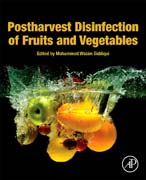
Postharvest Disinfection of Fruits and Vegetables describes available technologies to reduce microbial infection for maintaining the postharvest quality and safety. The book analyzes alternative and traditional methodologies pointing out the significant advantages and limitations of each technique facilitating both cost and time savings. This reference is for anyone on the fresh produce industry involved in postharvest handling and management providing the need information on the latest disinfection approaches, low-cost treatment strategies, management and protocols to control fresh produce qualities, diseases and insect infestation. Includes methods to reduce microbial contamination using chlorination, ozone, pulsed light, irradiation, and plasma technologyProvides practical applications of recently developed natural anti-microbial agents for eco-friendly and sustainable solutionsExplores various disinfection technologies for quality assurance and for the development of potential new technologies INDICE: 1. Postharvest disinfection of fruits and vegetables: an overview 2. Postharvest diseases of fruits and vegetables: recent advances 3. Induced resistance in fruits and vegetables against biotic stress using GRAS compounds 4. Aqueous Formulations 5. Sodium hypochlorite (NaOCl) 6. Calcium hypochlorite (CaCl2O2) 7. Peracetic acid 8. Electrolyzed reduction water 9. Ultrasonic processing technology 10. Hydrogen peroxide (H2O2) 11. Physical Treatments 12. Irradiation 13. UV-A, B, and C- 14. Ozone- Nikos 15. Plasma (thermal or cold plasma) 16. Chlorine gas 17. Sulfur dioxide 18. Chitosan
- ISBN: 978-0-12-812698-1
- Editorial: Academic Press
- Encuadernacion: Rústica
- Páginas: 300
- Fecha Publicación: 01/06/2018
- Nº Volúmenes: 1
- Idioma: Inglés
